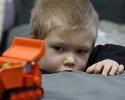The behavior and thoughts associated with obsessive-compulsive disorder or OCD, are often confusing to parents, teachers and peers. Realizing the symptoms of OCD may be quite challenging, as they can be mistakenly viewed as willful disregard, oppositional behavior or meaningless worry.
Additionally, children and adolescents normally try to hide their symptoms and try not to talk about their underlying apprehensions. Often, a parent or teacher only witnesses the end results of the symptoms, such as spending hours in the bathroom or throwing a temper tantrum when they aren’t given their way.
Symptoms of OCD in Children
The symptoms of OCD in children will vary with time and it may change in the way they appear, which can further make diagnosing the disorder quite complicated. Children may be able to resist the obsessive and compulsive nature of the behavior while at school, but are unable to avoid it at home. The symptoms could fluctuate, with more of them appearing during a stressful time and fewer showing up during other times. Other medical conditions may mimic the disorder, while other symptoms may co-occur with it.
If OCD is left untreated, it can wind up leading to considerable worry or limitations in different areas of a child’s life. Peer relations, school functioning, family interactions may all suffer. Depression is common in children with OCD. In some situations, depression might be the result of extreme anxiety, social isolation, and limited activities, a child could develop thoughts about suicide or self-harm. A trained child psychologist or pediatric neurologist should integrate information from a child’s home, school and during the clinical visit to make an accurate diagnosis.
How is OCD treated in Children?
OCD is a treatable, though ongoing disorder and intervention by a child’s medical practitioner, therapists, teacher and parents are a necessary part of managing it. The following treatments and interventions are commonly used in the home and school environment to optimize the quality of life a child with OCD can have:
•Cognitive behavioral therapy: through this type of treatment, a young person is helped to become aware of their obsessive and compulsive behaviors and given alternatives to try to control these actions.
•Individual psychotherapy: this type of treatment may be useful to young people with OCD, particularly when they try to deal with ongoing stress. Individual psychotherapy can help young people become aware of and address feelings of failure and self-blame.
•Parent guidance sessions: this type of therapy can help parents manage their child’s illness and teaches effective parenting skills, and teach all the people involved how to function as a family in spite of OCD.
•School-based counseling: this is effective in helping a child with OCD navigate through the social, behavioral and academic demands they face in school.
Conclusion:
It’s important for parents to seek an accurate diagnosis if they suspect their child has obsessive compulsive disorder. Additionally, flexibility and supportive environment in the home and at school are essential for the child to be able to reach his or her full potential. School faculty and parents should work together to be able to identify difficult situations and to develop remedies to assist a child during especially challenging or difficult times at home and in the classroom.

![By Lars Klintwall Malmqvist (Larsklintwallmalmqvist) (Own work) [Public domain], via Wikimedia Commons By Lars Klintwall Malmqvist (Larsklintwallmalmqvist) (Own work) [Public domain], via Wikimedia Commons](https://www.brainphysics.com/sites/default/files/images/256px-OCD_handwash_1.news3.jpg)





